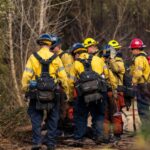In the rural landscapes of Shenandoah County, Virginia, a crisis has been brewing. At a recent public hearing on April 7th, Fort Valley residents expressed their concerns and frustrations over extended emergency medical service response times, which have left their community vulnerable when minutes matter most.
As advocates for firefighters and emergency responders nationwide, we find ourselves deeply invested in this unfolding situation that highlights broader challenges facing rural emergency services across America.
Current EMS Coverage in Fort Valley
The current emergency response system in Fort Valley operates under a “home response” model, where volunteer firefighters and emergency medical technicians respond to calls from their homes rather than from a staffed station. This approach, although cost-effective, has significant limitations in terms of response capability and timing.
The Fort Valley Fire Department relies entirely on volunteer personnel, with no dedicated EMS crew stationed locally. When medical emergencies occur, residents must wait for EMS teams from Strasburg, Woodstock, or Mount Jackson to arrive—communities that are all considerable distances away. In rural areas with winding roads and challenging terrain, these distances translate directly into prolonged response times that can mean the difference between life and death.

Lieutenant Chris Pangle of the Toms Brook Volunteer Fire Department highlighted that the funding shortfall affects volunteer departments across the entire county, not just Fort Valley. “The volunteer fire department as a whole has not had a huge increase over the last few years,” Pangle noted. “We definitely have to have an increase in our budget to keep going.”
Residents Voice Concerns Over EMS Response Times
During a Shenandoah County Board of Supervisors meeting, residents painted a vivid picture of a community in distress: unanswered calls, unavailable help, and long waits for medical assistance all played a role in someone’s disease, disability, or even the premature end of their life.
While the community is deeply grateful for the help they have received so far, realism has set in: the local all-volunteer crew does not always have the means to provide aid quickly.
The proposed solution? To ensure the area has access to a fully staffed Emergency Response department.
The proposed county budget for fiscal year 2026 includes a 10.79% increase in public safety funding compared to the previous year. However, residents quickly pointed out that only an additional $30,000 has been earmarked specifically for volunteer fire and rescue services, an amount many believe is woefully inadequate given the challenges faced by remote communities like Fort Valley.
County Officials Respond, Cite Staffing and Budget Limitations
County officials acknowledged the validity of residents’ concerns but pointed to broader systemic challenges that complicate immediate solutions.
Beyond financial considerations, the rural nature of Shenandoah County also presents inherent challenges for first responders. With just 86 people per square mile, their population is spread out across a wide area, and ambulances can’t speed or maneuver as nimbly as a regular sedan. As a result, the usual city-based model of coordinating a small fleet of vehicles from a central station would not improve response times for many. On the other hand, a decentralized crew needs more expensive staffing and upkeep.
“We hear your concerns, and we share them,” one county supervisor responded. “The challenge is finding sustainable solutions that work within our budgetary constraints while still meeting the emergency needs of all our communities.”
Why We Support Stories Like This One
EMS response times may be measured in minutes, but they often represent lives: each additional minute represents a 2% increase in mortality. When systems fail to deliver timely care, lives are unnecessarily lost. Each extra death represents a personal tragedy for a Shenandoah resident.
As an organization dedicated to firefighters and emergency responders, we view the situation in Fort Valley as emblematic of challenges faced by rural communities nationwide.
Stories like Fort Valley’s demonstrate why local voices matter in public safety discussions. Budget decisions made in county boardrooms have real-world consequences for families waiting for help during their most vulnerable moments. The courage of these residents to speak up highlights the critical importance of community advocacy in shaping public safety policy.








